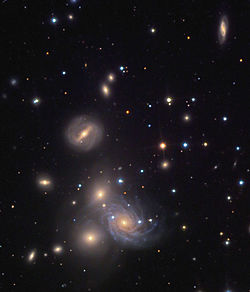
NGC 68 is a lenticular galaxy, and the central member of the NGC 68 group, in the constellation Andromeda. The galaxy was discovered on September 11, 1784, by William Herschel, who observed the NGC 68 group as a single object and described it as "extremely faint, large, 3 or 4 stars plus nebulosity". As such, his reported location is between NGC 68, NGC 70, and NGC 71. By the time Dreyer looked at the galaxies to add to the NGC catalog, however, he was able to tell that the single galaxy observed by Herschel was in fact 3 adjacent galaxies, and cataloged them as NGC 68, NGC 70, and NGC 71.

NGC 70 is a spiral galaxy located in the constellation Andromeda. It was discovered on October 7, 1855, by R. J. Mitchell and was also observed on December 19, 1897 by Guillaume Bigourdan from France who described it as "extremely faint, very small, round, between 2 faint stars".

NGC 71 is an elliptical galaxy located in the constellation Andromeda. It is in the NGC 68 group. The galaxy was discovered by R. J. Mitchell in 1855, and observed in 1865 by Heinrich d'Arrest, who described it as "extremely faint, very small, round". The galaxy is about 110,000-130,000 light years across, making it just slightly larger than the Milky Way. The galaxy is the second largest in the NGC 68 group, after spiral galaxy NGC 70.

NGC 72 is a barred spiral galaxy estimated to be about 320 million light-years away in the constellation of Andromeda. It was discovered by R. J. Mitchell in 1855 and its magnitude is 13.5.

NGC 7002 is a large elliptical galaxy around 320 million light-years away from Earth in the constellation of Indus. The galaxy was discovered by English astronomer John Herschel on September 30, 1834. NGC 7002 is also part of a group of galaxies that contains the nearby galaxy NGC 7004.

NGC 7010 is a massive elliptical galaxy located about 365 million light-years from Earth in the constellation Aquarius. NGC 7010 was discovered by astronomer John Herschel on August 6, 1823, and was later listed by French astronomer Guillaume Bigourdan as IC 5082.
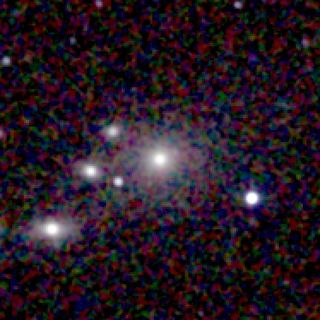
NGC 7012 is a large, bright elliptical galaxy located about 380 million light-years away from Earth in the constellation Microscopium. NGC 7012 was discovered by astronomer John Herschel on July 1, 1834.

NGC 7016 is an elliptical or lenticular galaxy located about 480 million light-years away from Earth in the constellation Capricornus. NGC 7016's calculated velocity is 11,046 km/s. NGC 7016 has an estimated diameter of about 140 thousand light years. NGC 7016 was discovered by American astronomer Francis Preserved Leavenworth on July 8, 1885.

NGC 7029 is an elliptical galaxy located about 120 million light-years away from Earth in the constellation Indus. NGC 7029 has an estimated diameter of 129,000 light-years. It was discovered by astronomer John Herschel on October 10, 1834. It is in a pair of galaxies with NGC 7022.
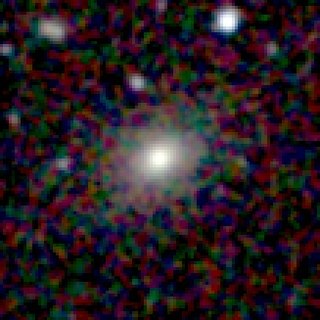
NGC 7034 is an elliptical galaxy located about 380 million light-years away in the constellation of Pegasus. It is part of a pair of galaxies that contains the nearby galaxy NGC 7033. NGC 7034 was discovered by astronomer Albert Marth on September 17, 1863.
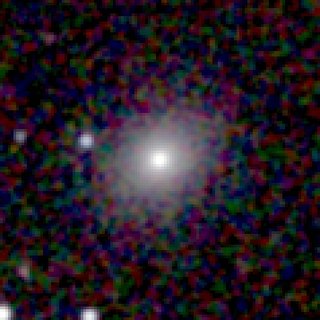
NGC 7057 is an elliptical galaxy located about 230 million light-years away in the constellation of Microscopium. NGC 7057 was discovered by astronomer John Herschel on September 2, 1836.

NGC 7061 is an elliptical galaxy located about 400 million light-years away in the constellation of Indus. NGC 7061 was discovered by astronomer John Herschel on September 30, 1834.

NGC 4489 is a dwarf elliptical galaxy located about 60 million light-years away in the constellation of Coma Berenices. It was discovered by astronomer William Herschel on March 21, 1784. NGC 4489 is a member of the Virgo Cluster.

NGC 4464 is an elliptical galaxy located about 70 million light-years away in the constellation of Virgo. NGC 4464 was discovered by astronomer William Herschel on December 28, 1785. NGC 4464 is a member of the Virgo Cluster.
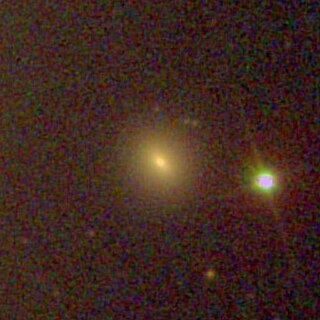
NGC 4467 is an elliptical galaxy located about 78 million light-years away in the constellation of Virgo. NGC 4467 was discovered by astronomer Otto Struve on April 28, 1851. NGC 4467 is a companion of Messier 49 and is a member of the Virgo Cluster.
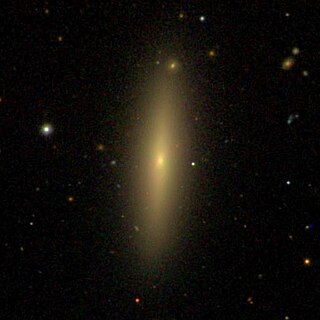
NGC 4623 is an edge-on lenticular or elliptical galaxy located about 54 million light-years away in the constellation of Virgo. NGC 4623 is classified as an E7, a rare type of "late" elliptical that represents the first stage of transition into a lenticular galaxy. NGC 4623 was discovered by astronomer William Herschel on April 13, 1784. NGC 4623 is a member of the Virgo Cluster.

NGC 4468 is a dwarf elliptical galaxy located about 55 million light-years away in the constellation of Coma Berenices. The galaxy was discovered by astronomer William Herschel on January 14, 1787. It is a member of the Virgo Cluster.

PGC 44691 is a spiral galaxy located about 350 million light-years away in the constellation Coma Berenices. It belongs to a galaxy cluster known as the Coma Cluster. In 1994, the Hubble Space Telescope observed PGC 44691 and the nearby elliptical galaxy NGC 4881 to infer the distance to the Coma Cluster.

NGC 4476 is a lenticular galaxy located about 55 million light-years away in the constellation Virgo. NGC 4476 was discovered by astronomer William Herschel on April 12, 1784. The galaxy is a member of the Virgo Cluster.

NGC 4482 is a dwarf elliptical galaxy located about 60 million light-years away in the constellation Virgo. NGC 4482 was discovered by astronomer William Herschel on March 15, 1784. It was rediscovered by astronomer Arnold Schwassmann on September 6, 1900 and was listed as IC 3427. It is a member of the Virgo Cluster.

